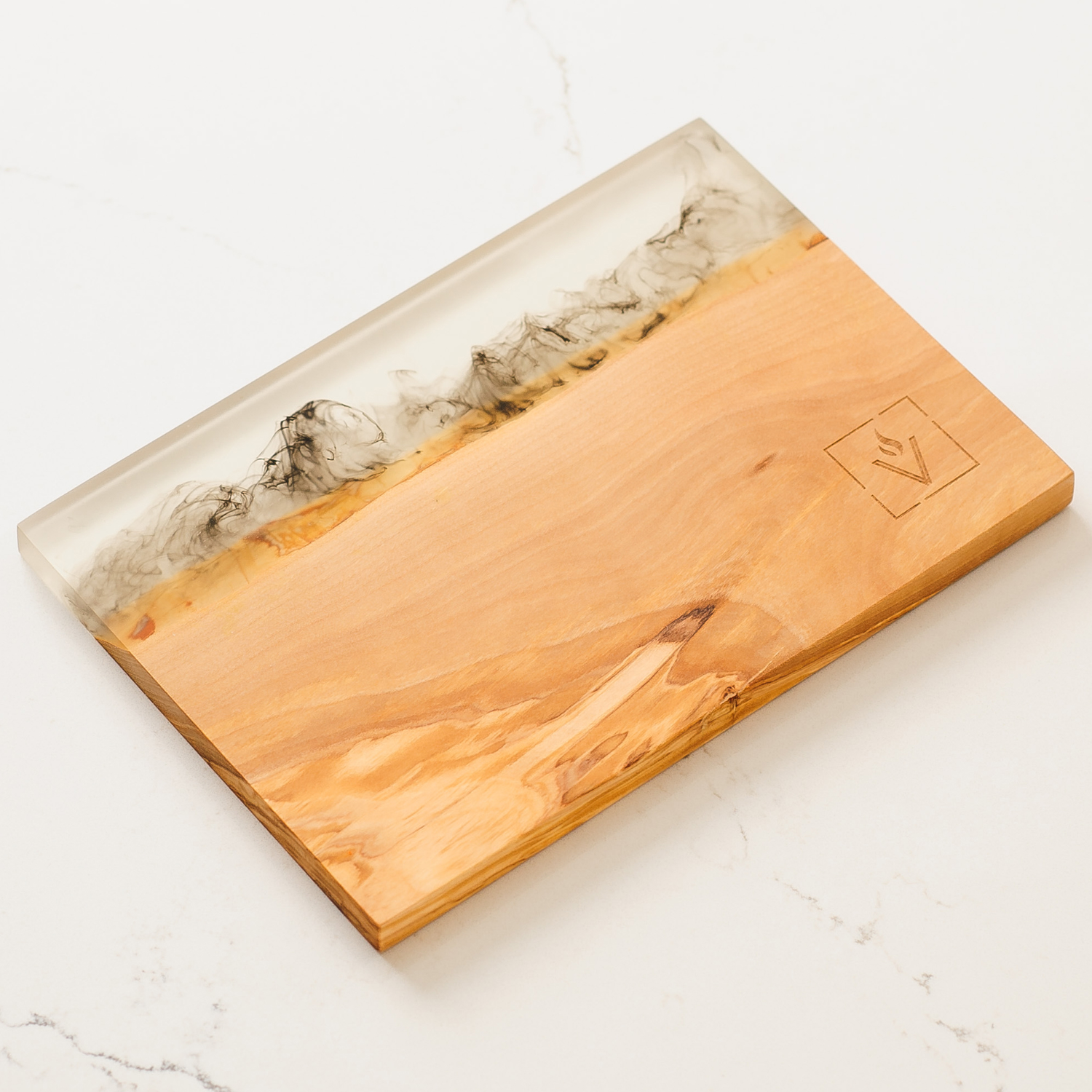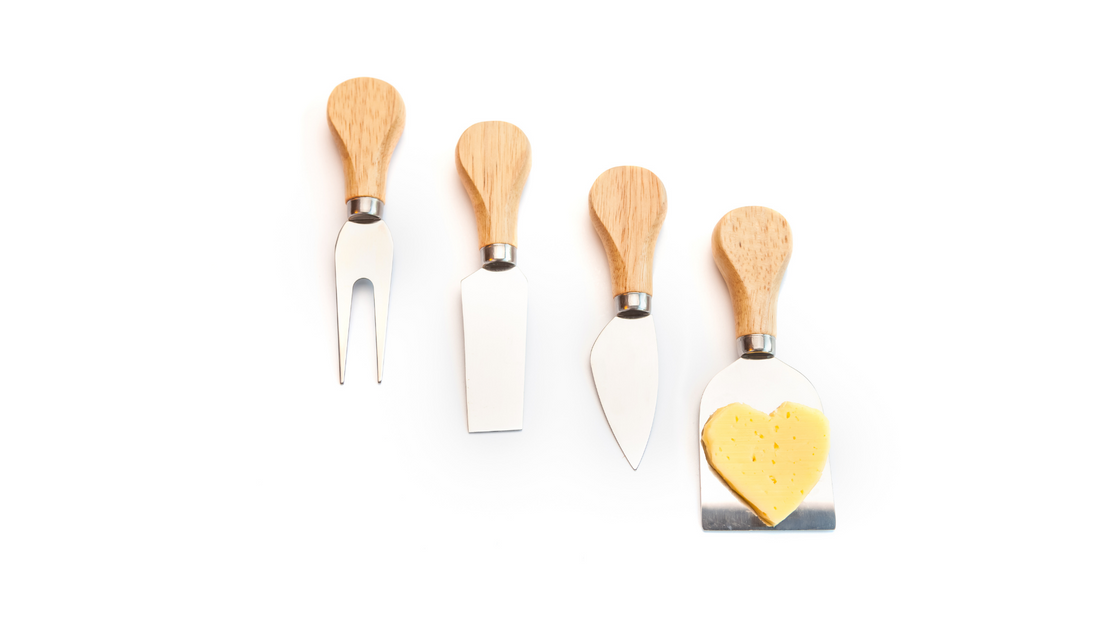A variety of cheese knives are appropriate to use with charcuterie boards. Each type delivers different advantages when you want to create a spread that’s beautiful and tasty to share with others – or keep for yourself!
Why Are Cheese Knives Different Shapes?
Cheese knives come in different shapes for a charcuterie board because each knife is meant for specific cheese types.
But why are the knives specialized?
Different cheeses react in different ways to the cutting process:
- Softer cheeses will be more spreadable
- Hard cheese will not spread, but you can slice it
- Really hard cheeses tend to shatter instead of slice
You wouldn’t want to use a soft cheese knife to cut a hard cheese block. Just as a meat cleaver isn’t meant for cutting bread, a steak knife isn’t appropriate for cutting cheese. You can use one to do the other, of course, but the results are often less than satisfactory.
Download our printer-friendly guide to charcuterie knives

The right tool can greatly benefit the ease in working with each texture. (It's kind of like trying to hammer-in a nail with a screwdriver. It IS possible - I've done it, but a hammer would be much easier and you're less likely to cause damage to anything).
Here are some types of cheese knives to consider based on the cheeses you plan to include in your next charcuterie board.
The Best Cheese Knife Types for Charcuterie Boards

Flat Cheese Knife (Spatula)
The chisel knife is an excellent choice for a charcuterie board when you prefer soft, crumbly cheeses like gorgonzola, bleu cheese, or feta. It features a paddle-style blade with a sharp bottom that glides through with ease from a vertical position. This design also works well for semi-soft cheeses like asiago, swiss, and provolone.
Plane Knife
With a sharp edge on one side and a soft edge on the other, this knife is designed to cut semi-firm cheese (cheddar, gouda, pepperjack).

Parm Knife
This cheese knife features a pointed edge that breaks chunks off the parmesan block – or other dry and hard cheeses. The sharp edge is particularly useful for cutting open the rind.

Serving Fork
This two-pronged cheese knife is perfect for picking up and serving already sliced hard and semi-hard cheeses.
Soft Cheese Knife
Sometimes called an open work blade, this knife has several holes to prevent the cheese from sticking to its surface. It has a sharp edge that works well for fresh mozzarella, camembert, or brie.

Gorgonzola Knife
Although it looks like a spreader, this knife has a shorter tang and longer, rounded blade with a sharp edge. That makes it perfect for any semi-soft, soft, and crumbly cheese you want to serve.

Pronged Cheese Knife
This unique cheese knife features an upward-curled blade with a sharp, pronged end. It’s a tool that makes it easier to pick up cheese slices or squares for serving. Because it has a narrow blade, it can work for everything from brie to parmesan.
Cleaver Cheese Knife
When you have this cheese knife available, it looks like you have a small meat cleaver. The design helps it cut through a hard cheese, allowing force and balance to create a successful outcome. When you grip the handle appropriately, your knuckles won’t hit the board.

Hard Cheese Knife
If you have this cheese knife in your collection, you’ll have a long, narrow blade that sometimes has two handles and the cutting surface between them. By taking this design approach, it’s easier to deliver even pressure distribution.

Cheese Spreader
A cheese spreader features a soft blade and flat surface for spreading soft cheeses on crackers and bread.
What Knives Are Best for Cutting Cheese?
Although different blades and shapes will work for all cheeses, you’ll find some are made to work with specific options. Just as you wouldn’t want to use a bread knife for mincing garlic, you wouldn’t want to use a soft cheese knife for cutting into a cheddar block.
It makes sense, then, that more than a dozen types of cheese knives exist. But you don't need to own all of them to make a successful charcuterie platter. Some cheese knives are so specialized that they are seldom used. That said, don’t skip out on these four tools.
1. Spatula
Why it's essential: Many charcuterie boards include soft, crumbly cheeses. This tool is made to glide through them with ease.
2. Plane Knife
Why it's essential: While the spatula can cut through semi-firm cheese, this knife will enable you to complete the same task easier, since you can cut from the side instead of pushing straight down.
3. Parm Knife
Why it's essential: This pointed tool enables you to score the rinds of hard cheese. Once it's scored, the sharp edge will help you slice through the cheese.
4. Serving Fork
Why it's essential: Once your cheeses are cut, you'll need to transfer them to your guests' plates. This tool is made for that task.
With those four tools on hand, you’ll be equipped to slice, dice, and serve nearly any cheese on your platter.
As a bonus, some of these same tools can be used to serve meat. The plane knife could be used to cut through certain softer meats in lieu of a cleaver. The serving fork can pick up and transfer hard salami. The parm knife is small enough that it could be used to spread pate. Of course, these are “off-label” uses for the knives. But the point stands. These four knives are truly useful for serving charcuterie.
You’ll find that when you come to a charcuterie board with the right tools, it is much easier to achieve the desired outcome. The best cheese knives can help you slice, dice, and spread with ease. Our charcuterie board gift set includes the four cheese knives mentioned above to make entertaining easier.
How Do You Properly Cut Cheese?
Is there really a proper way to cut cheese? Well, yes, and no.
If you don't use the "right" knife to serve charcuterie, it's not like you'll become some sort of social pariah. Charcuterie is meant to be fun! And you could in theory use any one knife to cut through most cheese.
However, cheesemongers will say that there is a way to cut cheese so as to aid the flavors in each cheese, both in enhancing the flavor in the piece you just took, and in the preservation of the flavor in the cheese you've left behind.
So, if you're interested in learning how to cut cheese the cheesemonger way, read on.
After you’ve decided what cheese knives are appropriate for your charcuterie board, it is time to learn how to cut each block, wheel, or wedge appropriately.
Tip: To avoid mixing flavors when cutting cheeses, it’s best to have multiple cheese knives on hand. There is such a thing as cheese flavor contamination! And some cheeses, like bleu cheese, can have pretty potent flavors. You wouldn’t want a strong cheese to mask the flavor of your mild havarti during the cutting process!
Cutting Soft Cheese
When you have soft cheese, it helps to form slices along the product’s longest edge. You don’t want to cut the nose or tip because that’s where the most flavor exists.
Tips:
- Soft cheeses are easier to cut while cold
- Pre-cut your brie to help eliminate people from digging out the cream and leaving a husk of a rind behind for people to dig from
- Pre-cut your goat cheese into moderately thick logs to help prevent it from crumbling, making it a little easier to spread
Cutting Cheese Wedges
If you have wedges to fashion, you’ll want to take the cheese knife blade along its widest edge until you reach about halfway. At that point, you’ll cut the top half along the border.
Tip:
Maintain the wedge: the flavor changes from the center outward, so each piece should have the full range of nuanced flavor
Cutting Hard Cheese
Cheese blocks need to be cut in half to create two rectangular portions first. Once you’ve taken that step, you can cut along the width portion to make slices. Some people like to cut these squares into triangles for design elements on their charcuterie board.
Tips:
1. Really hard cheeses usually have a natural breaking point where each curd used to be, so you can simply dig your knife into the cheese and let the breakpoints crumble off the cheese to creak chunky pieces
2. If you have a cheese log, slice down its length to create discs or medallions.
Which Cheeses Should I Get for Charcuterie?
We have a post for that! Check out our tutorial for guidance on what to put on a traditional cheese board.
That said, our top five picks are:
- Machego, which is an intense and zesty hard cheese
- Gouda, which is a mild and buttery semi-soft cheese
- Brie, which is creamy in texture and earthy in flavor
- Cheddar, which is a bitter and nutty hard cheese
- Wine cheeses, which have heady overtones
- Chevre, which is tangy and earthy
Of course, part of the fun in charcuterie is the open-ended creativity. So if you're making a board, have fun mixing and matching cheeses of different textures and flavors.






